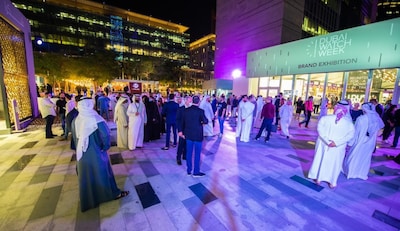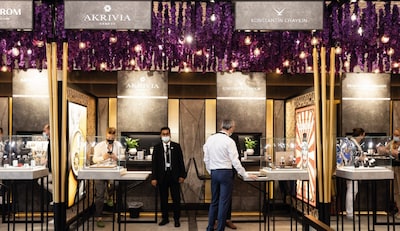Dubai Watch Week is re-writing the rule book on watch fairs
By Robin Swithinbank | 3 minute read

Closing out a year in which the once mighty, now sadly depleted Baselworld was forced to postpone and the new-look Watches & Wonders went ‘digital only’, it fell to last month’s Dubai Watch Week to fan the flames of horological passion with five days of in-person panels, masterclasses, and special exhibition – as well as a watch launch or two.
More than 40 brands assembled at the Gate in Dubai’s International Finance Centre for the fifth (biennial) edition of the Middle East’s premier watch event, including the headliners Rolex, Audemars Piguet and Hublot, although not all brought new watches with them. Of those that did, Girard-Perregaux had the lion’s share, revealing a suite of new pieces to close off its 230th anniversary, including a stunning wristwatch inspired by its 1889 La Esmerelda Tourbillon pocket watch, and a pair of enamel-dialled steel Laureatos dubbed the ‘Eternity’ editions.
Oris wasn’t far behind with a pairing of its own. First was a stylish, colourful revamp of its Rectangular collection (the blue and Bordeaux variants are simply terrific), but the hero was the Big Crown Pointer Date Calibre 403. Back in the summer, Oris created a limited-edition version of its signature design powered by its new in-house automatic, but at just 250 pieces, it left Oris fans wondering when the brand would introduce a collection piece.
Now it has. As with Oris’s other Calibre 400 Series watches, this humble-looking piece packs a five-day power reserve, the sort of antimagnetic properties that should mean it’s never magnetised during ‘normal’ use, and a 10-year warranty. For a watch costing £2,600, that’s highly impressive.

Sticking with newness, H. Moser & Cie.’s Heritage Bronze ‘Since 1828’ Limited Edition returned the brand to its Russian roots with a dial carrying a version of the company’s logo written in Cyrillic, while high-end independent watchmaker Greubel Forsey signalled its intentions to grow its story with the Balancier S2, a 46.5mm titanium piece that sits at the lower end of its price spectrum (although it will still come in at around £165,000). Ulysse Nardin was in a fresh mood too, adding another version of its fine-watchmaking dive watch, the Diver X Skeleton Black, this time with a bezel made of a carbon-fibre material called ‘Carbonium’ and punchy yellow accents.
Dubai Watch Week isn’t really about new watches, though. It’s about conversations, sharing ideas and celebrating watchmaking. Panels devoted to subject matters as diverse as sustainability, cryptocurrency and the art of collecting were welcome (and now on YouTube), and cast light on where the industry is heading.
All told, some 15,000 people visited Dubai Watch Week this year. That’s up from 9,000 two years ago and no small achievement given the effects of the pandemic, but still small by watch fair standards (at its peak Baselworld attracted more than 100,000). But what it showed was that regional, less formal, more conversational fairs taking place around the world are the future. In a globalised world where people are increasingly thinking locally, the model makes sense, after all. Long live the – regional – watch fair!
Robin Swithinbank is an independent journalist and former Calibre editor. He is a regular contributor to The New York Times International, Financial Times, GQ, Hodinkee and Robb Report.